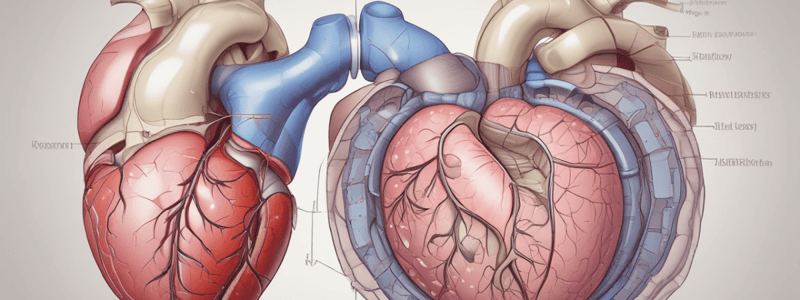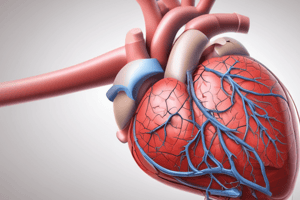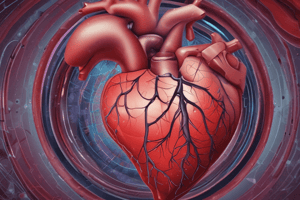Podcast
Questions and Answers
What distinguishes acquired heart defects from congenital ones?
What distinguishes acquired heart defects from congenital ones?
- Acquired heart defects occur after birth due to heart disease. (correct)
- Acquired defects are more common than congenital defects.
- Congenital heart defects are caused by damage to the valvular apparatus.
- Congenital defects are related to endocarditis.
Which of the following is NOT listed as a cause of acquired heart defects?
Which of the following is NOT listed as a cause of acquired heart defects?
- Rheumatism
- Bacterial endocarditis
- Atherosclerosis
- Genetic predisposition (correct)
What can occur when the valve cusps are destroyed due to ulcerative endocarditis in acquired heart defects?
What can occur when the valve cusps are destroyed due to ulcerative endocarditis in acquired heart defects?
- Hemodynamic disturbances
- Chronic heart disease
- Acute heart disease (correct)
- Congenital heart disease
What do sclerotic changes in the valvular apparatus lead to in acquired heart defects?
What do sclerotic changes in the valvular apparatus lead to in acquired heart defects?
If a heart defect involves both valve insufficiency and stenosis, what is it referred to as?
If a heart defect involves both valve insufficiency and stenosis, what is it referred to as?
How do hemodynamic disturbances contribute to the progression of acquired heart defects?
How do hemodynamic disturbances contribute to the progression of acquired heart defects?
What is the predominant cause of mitral valve disease mentioned in the text?
What is the predominant cause of mitral valve disease mentioned in the text?
Which type of mitral valve defect is more common, based on the text?
Which type of mitral valve defect is more common, based on the text?
What is a possible consequence of mitral valve insufficiency according to the text?
What is a possible consequence of mitral valve insufficiency according to the text?
What distinguishes the appearance of a narrowed mitral valve opening in mitral stenosis?
What distinguishes the appearance of a narrowed mitral valve opening in mitral stenosis?
What condition can develop due to hypertension in the small circulation associated with mitral stenosis?
What condition can develop due to hypertension in the small circulation associated with mitral stenosis?
What disease is mentioned as the second most frequent after mitral valve disease?
What disease is mentioned as the second most frequent after mitral valve disease?
What type of change is primarily seen in aortic valve disease due to rheumatism?
What type of change is primarily seen in aortic valve disease due to rheumatism?
What is the result of aortic valve insufficiency on the heart, as per the text?
What is the result of aortic valve insufficiency on the heart, as per the text?
Which type of defects are rarely acquired on the basis of rheumatism, syphilis, sepsis, and atherosclerosis?
Which type of defects are rarely acquired on the basis of rheumatism, syphilis, sepsis, and atherosclerosis?
What distinguishes decompensated heart disease from compensated heart disease according to the text?
What distinguishes decompensated heart disease from compensated heart disease according to the text?
What is the primary outcome of concentric myocardial hypertrophy in the heart?
What is the primary outcome of concentric myocardial hypertrophy in the heart?
What is the characteristic feature of decompensated heart disease?
What is the characteristic feature of decompensated heart disease?
What is the primary cause of cardiovascular insufficiency in patients with heart disease?
What is the primary cause of cardiovascular insufficiency in patients with heart disease?
What percentage of children die from congenital heart defects in the perinatal period?
What percentage of children die from congenital heart defects in the perinatal period?
What is the primary etiological factor in the development of congenital heart defects?
What is the primary etiological factor in the development of congenital heart defects?
During which period of intrauterine development does the damaging agent affect the embryo to cause congenital heart defects?
During which period of intrauterine development does the damaging agent affect the embryo to cause congenital heart defects?
What is a characteristic feature of congenital heart defects in children less than 3 months old?
What is a characteristic feature of congenital heart defects in children less than 3 months old?
What is the outcome of compensatory restructuring of the vascular bed of the hypertrophied heart?
What is the outcome of compensatory restructuring of the vascular bed of the hypertrophied heart?
What is the primary consequence of congenital heart defects in children?
What is the primary consequence of congenital heart defects in children?
Which type of septal defect is associated with the development of a three-chambered heart?
Which type of septal defect is associated with the development of a three-chambered heart?
What causes the hypoxia in blue type heart defects?
What causes the hypoxia in blue type heart defects?
What is the direction of blood flow in a ventricular septal defect?
What is the direction of blood flow in a ventricular septal defect?
Which type of septal defect is associated with the expansion of the trunk and branches of the pulmonary artery?
Which type of septal defect is associated with the expansion of the trunk and branches of the pulmonary artery?
Which type of defect is often combined with a defect of the interventricular partition?
Which type of defect is often combined with a defect of the interventricular partition?
What is the cause of hypoxia in white type heart defects?
What is the cause of hypoxia in white type heart defects?
What is the most common type of ventricular septal defect?
What is the most common type of ventricular septal defect?
Which type of heart defect is characterized by a common arterial trunk originating from both ventricles?
Which type of heart defect is characterized by a common arterial trunk originating from both ventricles?
Which type of septal defect is associated with the development of hypertrophy of the right ventricle?
Which type of septal defect is associated with the development of hypertrophy of the right ventricle?
What is the location of a defect in the primary atrial septum?
What is the location of a defect in the primary atrial septum?
What is the primary cause of the arterial blood entering the systemic circulation in case of complete transposition of the pulmonary artery and aorta?
What is the primary cause of the arterial blood entering the systemic circulation in case of complete transposition of the pulmonary artery and aorta?
What are the signs of the pentad of Fallot?
What are the signs of the pentad of Fallot?
What is the primary cause of arterial blood entering the lungs in case of stenosis and atresia of the aorta?
What is the primary cause of arterial blood entering the lungs in case of stenosis and atresia of the aorta?
What is the primary cause of the development of collateral circulation in case of non-closure of the arterial (ductus Botalli) duct?
What is the primary cause of the development of collateral circulation in case of non-closure of the arterial (ductus Botalli) duct?
What are the features of the triad of Fallot?
What are the features of the triad of Fallot?
What are the features of the tetralogy of Fallot?
What are the features of the tetralogy of Fallot?
What is the primary cause of arterial blood entering the lungs in case of significant narrowing of the pulmonary artery?
What is the primary cause of arterial blood entering the lungs in case of significant narrowing of the pulmonary artery?
What are the primary features of ventricular septal defect with stenosis of the left atrioventricular orifice (Lutembacher's disease)?
What are the primary features of ventricular septal defect with stenosis of the left atrioventricular orifice (Lutembacher's disease)?
What are the primary features of a branch of the left coronary artery from the pulmonary trunk (Bland-White-Garland syndrome)?
What are the primary features of a branch of the left coronary artery from the pulmonary trunk (Bland-White-Garland syndrome)?
What are the primary features of primary pulmonary hypertension (Aerz's disease)?
What are the primary features of primary pulmonary hypertension (Aerz's disease)?
Flashcards are hidden until you start studying





